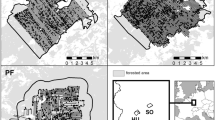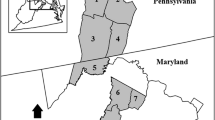Abstract
Population size information is critical for managing endangered or harvested populations. Population size can now be estimated from non-invasive genetic sampling. However, pitfalls remain such as genotyping errors (allele dropout and false alleles at microsatellite loci). To evaluate the feasibility of non-invasive sampling (e.g., for population size estimation), a pilot study is required. Here, we present a pilot study consisting of (i) a genetic step to test loci amplification and to estimate allele frequencies and genotyping error rates when using faecal DNA, and (ii) a simulation step to quantify and minimise the effects of errors on estimates of population size. The pilot study was conducted on a population of red deer in a fenced natural area of 5440 ha, in France. Twelve microsatellite loci were tested for amplification and genotyping errors. The genotyping error rates for microsatellite loci were 0–0.83 (mean=0.2) for allele dropout rates and 0–0.14 (mean=0.02) for false allele rates, comparable to rates encountered in other non-invasive studies. Simulation results suggest we must conduct 6 PCR amplifications per sample (per locus) to achieve approximately 97% correct genotypes. The 3% error rate appears to have little influence on the accuracy and precision of population size estimation. This paper illustrates the importance of conducting a pilot study (including genotyping and simulations) when using non-invasive sampling to study threatened or managed populations.
Similar content being viewed by others
References
Bayes M, Smith K, Alberts S, Altmann J, Bruford M (2000) Testing the reliability of microsatellites typing from faecal DNA in the savannah baboon. Cons Genet 1:173–176
Bonin A, Bellemain E, Bronken Eidsen P, Pompanon F, Brachmann C, Taberlet P (2004) How to track and assess genotyping errors in population genetics studies. Mol Ecol 13:3261–3273
Bonnet A (2001) Etude chromosomique et moléculaire de la sous-famille des Cervinae: application des résultats à la gestion des troupeaux en captivité d’espèces sauvages. PhD Thesis, University of Tours, Tours, France
Bonnet A, Thévenon S, Maudet F, Maillard JC (2002) Efficiency of semi-automated fluorescent multiplex PCRs with 11 microsatellite markers for genetic studies of deer populations. Anim Genet 33:343–350
Cederlund G, Bergqvist J, Kjellander P, Gill R, Gaillard J-M, Boiseaubert B, Ballon P, Duncan P (1998) Managing roe deer and their impact on the environment: maximising the net benefits to society. In: Andersen R, Duncan P, Linnell JDC (eds) The European roe deer: the biology of success. Scandinavian University Press, Oslo, pp 337–372
Constable J, Ashley M, Goodall J, Pusey A (2001) Noninvasive paternity assignment in Gombe chimpanzees. Mol Ecol 10:1279–1300
Creel S, Spong G, Sands JL, Rotella J, Zeigle J, Joe L, Murphy KM, Smith D (2003) Population size estimation in Yellowstone wolves with error-prone noninvasive microsatellite genotypes. Mol Ecol 12:2003–2009
Eggert LS, Eggert JA, Woodruff DS (2003) Estimating population sizes for elusive animals: the forest elephants of Kakum National Park, Ghana. Mol Ecol 12:1389–1402
Ernest H, Penedo M, May B, Syvanen M, Boyce W (2000) Molecular tracking of mountain lions in the Yosemite Valley in California: genetic analysis using microsatellites and faecal DNA. Mol Ecol 9:433–441
Frantz A, Pope L, Carpenter P, Roper T, Wilson G, Delahay R, Burke T (2003) Reliable microsatellite genotyping of the Eurasian badger (Meles meles) using faecal DNA. Mol Ecol 12:1649–1661
Gagneux P, Boesch C, Woodruff S (1997) Microsatellite scoring errors associated with noninvasive genotyping based on nuclear DNA amplified from shed hair. Mol Ecol 6:861–868
Garnier J, Bruford M, Goossens B (2001) Mating system and reproductive skew in the black rhinoceros. Mol Ecol 10:2031–2041
Goossens B, Chikhi L, Utami, S. de Ruiter J, Bruford M (2000) A multi-samples, multi-extracts approach for microsatellite analysis of faecal samples in an arboreal ape. Cons Genet 1:157–162
Huber S, Bruns U, Arnold W (2002) Sex determination of red deer using polymerase chain reaction of DNA from feces. Wildl Soc Bull 30:208–212
Ihaka R, Gentleman R (1996) R: a language for data analysis and graphics. J Comput Graph Stat 5:299–314
Kohn MH, Wayne RK (1997) Facts from feces revisited. Trends Ecol Evol 12:223–227
Kohn MH, York E, Kamradt DA, Haught G, Sauvajot R, Wayne RK (1999) Estimating population size by genotyping faeces. Proc R Soc Lond Ser B 266:657–663
Lathuillière M, Ménard N, Gautier-Hion A, Crouau-Roy B (2001) Testing the reliability of noninvasive genetic sampling by comparing analyses of blood and fecal samples in Barbary Macaques (Macaca sylvanus). Am J Primatol 55:151–158
Launhardt K, Epplen C, Epplen J, Winkler P (1998) Amplification of microsatellites adapted from human systems in faecal DNA of wild Hanuman langurs (Presbytis entellus). Electrophoresis 19:1356–1361
Marques FFC, Buckland ST, Goffin D, Dixon CE, Borchers DL, Mayle BA, Peace AJ (2001) Estimating deer abundance from line transect surveys of dung: sika deer in southern Scotland. Ecology 38:349–363
Marshall TC, Slate J, Kruuk LEB, Pemberton JM (1998) Statistical confidence for likelihood-based paternity inference in natural populations. Mol Ecol 7:639–655
Mills LS, Citta JJ, Lair K, Schwartz M, Tallmon D (2000) Estimating animal abundance using non-invasive DNA sampling: promise and pittfalls. Ecol Appl 10:283–294
Morin P, Chambers K, Boesch C, Vigilant L (2001) Quantitative polymerase chain reaction analysis of DNA from noninvasive samples for accurate microsatellite genotyping of wild chimpanzees (Pan troglodytes verus). Mol Ecol 10:1835–1844
Mowat G, Paetkau D (2002) Estimating marten population size using hair capture and genetic tagging in Southeastern British Columbia. J Wildlife Manage 8(3)
Navidi W, Arnheim N, Waterman MS (1992) A multitubes approach for accurate genotyping of very small DNA sample using PCR: statistical considerations. Am J Hum Genet 50:347–359
Otis DL, Burnham KP, White GC, Anderson DR (1978) Statistical inference from capture data on closed animal populations. Wildl Monogr 62
Paetkau D (2003) An empirical exploration of data quality in DNA-based population inventories. Mol Ecol 12:1375–1387
Parsons K (2001) Reliable microsatellite genotyping of dolphin DNA␣from faeces. Mol Ecol Notes 1:341–344
Piggot MP, Bellemain E, Taberlet P, Taylor AC (2004) A multiplex pre-amplification method that significantly improves microsatellite amplification and error rates for faecal DNA in limiting conditions. Cons Genet 5:417–420
Raymond M, Rousset F (1995) GENEPOP (version 1.2): population genetics software for exact tests and ecumenicism. J Hered 86:248–249
Schwartz CJ, Seber AF (1999) A review of estimating animal abundance. Stat Sci 14:427–456
Seber AF (1982) The estimation of animal abundance and related parameters. C. Griffin & Co. Ltd., London
Segelbacher G (2002) Noninvasive genetic analysis in birds: testing reliability of feather samples. Mol Ecol Notes 2(3):367–369
Sloane M, Sunnucks P, Alpers D, Beheregaray L, Taylor A (2000) Highly reliable genetic identification of individual northern hairy-nosed wombats from single remotely collected hairs: a feasible censuring method. Mol Ecol 9:1233–1240
Taberlet P, Griffin S, Goossens B, Questiau S, Manceau V, Escaravage N, Waits LP, Bouvet J (1996) Reliable genotyping of samples with very low DNA quantities using PCR. Nucleic Acids Res 24:3189–3194
Taberlet P, Luikart G (1999) Non-invasive genetic sampling and individual identification. Biol J Linn Soc 68:41–55
Valière N (2002a) GIMLET: a computer program for analysing genetic individual identification data. Mol Ecol Notes 2:377–379
Valière N (2002b) Amélioration et optimisation des méthodes non-invasives et des marqueurs microsatellites en Biologie des Populations et de la Conservation. PhD Thesis, Claude Bernard Lyon I, Lyon, France.
Valière N, Berthier P, Mouchiroud D, Pontier D (2002) GEMINI: software for testing the effects of genotyping errors and multitubes approach for individual identification. Mol Ecol Notes 2:83–86
Waits J, Leberg P (2000) Biases associated with population estimation using molecular tagging. Anim Conserv 3:191–199
Waits LP, Luikart G, Taberlet P (2001) Estimating the probability of identity among genotypes in natural populations: cautions and guidelines. Mol Ecol 10:249–256
Walsh PS, Metzger DA, Higushi R (1991) Chelex100 as a medium for simple extraction of DNA for PCR-based typing forensic material. BioTechniques 10:506–513
Wemmer C (1997) The challenge of conserving large mammals, with␣an emphasis on deer. In: McShea MJ, Underwood HB, Rappole JH (eds) The science of overabundance: deer ecology and population managment. Smithsonian Institution Press, Washington, D.C., pp 55–66
Williams BK, Nichols JD, Conroy M (2002) Analysis and management of animal populations: modeling, estimation, and decision making. Academic Press, San Diego
Wilson GJ, Frantz AC, Pope LC, Roper TJ, Burke TA, Cheeseman CL, Delahay RJ (2003) Estimation of badger abundance using faecal DNA typing. J Appl Ecol 40:658–666
Woods J, Paetkau D, Lewis D, McLellan B, Proctor M, Strobeck C (1999) Genetic tagging of free-ranging black and brown bears. Wildl Soc Bull 27(3):616–627
Acknowledgements
The authors would thanks staff of Office National des Forêts (ONF) and Office National de la Chasse (ONCFS), Aurélie Cohas and Ondine Lucas for their help in the field. We also greatly thanks Francis Forget (ONF), Christian Gambier (ONF) and Dominique Odier (ONCFS) for their cooperation. We thanks E. Petit, Joe Niegel and two anonymous reviewers for their comments on previous version of this manuscript. Funding for this project was provided by the ONCFS (contract CNRS-ONCFS no 2002/08).
Author information
Authors and Affiliations
Corresponding author
Rights and permissions
About this article
Cite this article
Valière, N., Bonenfant, C., Toïgo, C. et al. Importance of a pilot study for non-invasive genetic sampling: genotyping errors and population size estimation in red deer. Conserv Genet 8, 69–78 (2007). https://doi.org/10.1007/s10592-006-9149-2
Received:
Accepted:
Published:
Issue Date:
DOI: https://doi.org/10.1007/s10592-006-9149-2




